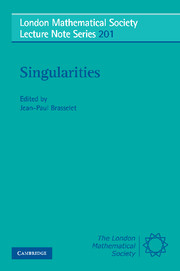Book contents
- Frontmatter
- Contents
- Introduction
- Plenary Conferences
- Specialized Conferences
- List of participants
- On Complex Projective Hypersurfaces which are Homology-Pn's
- Generic Geometry and Duality
- An arithmetical factorization for the critical point set of some map germs from C2 to C2
- Trivializations of stratified spaces with bounded differential
- Moduli for Singularities
- Conormal space and Jacobian modules: A short dictionary
- Weak Lefschetz and Topological q-Completeness
- Volumes and lattice points - proof of a conjecture of L. Ehrenpreis
- Connexions méromorphes
- Deformations of maps on complete intersections, Damon's Kv-equivalence and bifurcations
- Cycles évanescents et faisceaux pervers II: cas des courbes planes réductibles
- A Desingularization Theorem for Systems of Microdifferential Equations
- Topological Stability
- Boundary Fronts and Caustics and their Metamorphoses
- Quid des stratifications canoniques
- Irrégularité des revêtements cycliques
Generic Geometry and Duality
Published online by Cambridge University Press: 05 May 2013
- Frontmatter
- Contents
- Introduction
- Plenary Conferences
- Specialized Conferences
- List of participants
- On Complex Projective Hypersurfaces which are Homology-Pn's
- Generic Geometry and Duality
- An arithmetical factorization for the critical point set of some map germs from C2 to C2
- Trivializations of stratified spaces with bounded differential
- Moduli for Singularities
- Conormal space and Jacobian modules: A short dictionary
- Weak Lefschetz and Topological q-Completeness
- Volumes and lattice points - proof of a conjecture of L. Ehrenpreis
- Connexions méromorphes
- Deformations of maps on complete intersections, Damon's Kv-equivalence and bifurcations
- Cycles évanescents et faisceaux pervers II: cas des courbes planes réductibles
- A Desingularization Theorem for Systems of Microdifferential Equations
- Topological Stability
- Boundary Fronts and Caustics and their Metamorphoses
- Quid des stratifications canoniques
- Irrégularité des revêtements cycliques
Summary
INTRODUCTION
Singularity theory is not a theory in the usual (axiomatic) sense. Indeed it is precisely its width, its vague boundaries and its interaction with other branches of mathematics, and science, which makes it so attractive. Our subject then rather defies a neat definition. This nebulous nature can, however, lead to identity crises and I then find it useful to think of singularity theory as the direct descendant of the differential calculus. It has, for example, the same concerns with Taylor series, and one can view much current research as natural extensions of problems which our forefathers laboured with, and considered central. The calculus is the tool, par excellence (sadly my only concession to the French language) for studying physics, differential equations in general and the geometry of curves and surfaces. Consequently one might hope that singularity theory will have applications in these fields. Indeed one might judge the vigour of the subject by its success in these areas.
In this paper I will focus on applications to the differential geometry of surfaces in Euclidean and projective 3-space, for three reasons. First its familiarity: this is a classical area known to all professional mathematicians, with a high intuitive content. Secondly any originality here is a good measure of success, this is a well worn path to take. And finally because it illustrates in a quite striking way the benefits which accrue when one moves from studying linear and quadratic phenomena to those of higher order.
- Type
- Chapter
- Information
- Singularities , pp. 29 - 60Publisher: Cambridge University PressPrint publication year: 1994
- 1
- Cited by



